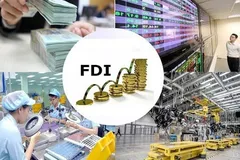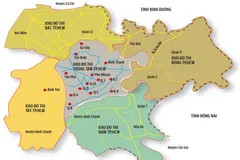
This disparity has intensified liquidity pressures, compelling even the largest banks to adjust mobilisation interest rates. However, amid these challenges, credit activity remains robust, with banks engaging in a quiet yet fierce competition to attract customers.
The Boom in “Refinancing” Loans
Recently, many borrowers with long-term loans at Bank A have reported receiving frequent calls from representatives of Bank B. These calls typically offer loans at lower interest rates, allowing customers to pay off their existing debts at Bank A. For instance, customers paying over 10% annual interest at Bank A are enticed with rates as low as 7% per year at Bank B for the first 12 months. Even after the promotional period, the interest rate at Bank B often remains more competitive than that of Bank A. Notably, these refinancing loans often come without penalty fees for early repayment.
This practice has gained traction following the introduction of Circular 06/2023/TT-NHNN, which amended Circular 39/2016/TT-NHNN. Effective from 1 September 2023, the updated regulations permit banks to extend loans to customers for repaying debts at other institutions, provided two conditions are met: the new loan term does not exceed the remaining term of the original loan, and the existing loan has not been restructured.
Under this model, commonly termed "refinancing," the new bank directly transfers the repayment amount to the original lender, settling the borrower’s debt. This approach has spurred fierce competition among banks, leading to a proliferation of preferential lending policies aimed at capturing this segment of the market.
Vietcombank was among the first to capitalise on this opportunity, launching promotional rates as low as 6.9% annually for the first six months, 7.5% for the first year, or 8% for the initial 24 months. Following this, BIDV introduced short-term loan rates starting at just 6% annually, with medium- and long-term loans offered from 6.8%. These loans also feature terms of up to 30 years, provided they do not exceed the remaining term of the original loan.
Not to be left behind, Agribank and VietinBank entered the fray, offering medium- and long-term loans at interest rates ranging from 6% to 7% annually. Similarly, MB Bank extended its portfolio to include loans for diverse purposes such as real estate purchases, home renovations, business expansion, and consumption. With rates starting at 7.5% per year, MB also offered an additional 1.5% reduction for the subsequent year.
In 2024, the competition intensified further. VIB unveiled attractive incentives, including fixed interest rates as low as 5.9% annually for six months, 6.9% for 12 months, and 7.9% for 24 months. Customers could also benefit from an additional 0.4% interest rate reduction, principal exemptions for up to 60 months, and post-incentive margins as low as 2.9%.
A Paradox: Capital Shortages Amid Active Lending
Despite the flurry of lending activities, the banking system faces a significant mismatch between credit growth and capital mobilisation. Data from the State Bank of Vietnam (SBV) reveals that outstanding debt across the economy has reached VND 15.3 quadrillion, while mobilised capital lags behind at VND 14.8 quadrillion. Credit growth as of 7 December stands at 12.5%, outpacing the 7.36% growth in mobilised capital.
To address liquidity challenges, the SBV has stepped in, injecting nearly VND 60.55 trillion into the system in November 2024 alone. This intervention aligns with the government’s directive to meet the economy’s capital demands, support production and business activities, and achieve the annual credit growth target of 15%.
Despite these measures, banks remain highly proactive in seeking ways to channel capital into the market. The SBV’s representative acknowledged that, in addition to conventional mobilisation, the central bank’s policy tools play a crucial role in sustaining liquidity. Consequently, banks are intensifying their efforts to lend, driven by annual growth targets and the pursuit of higher profits. This drive has led to a widespread embrace of refinancing loans as a strategic avenue for customer acquisition.
Refinancing has emerged as a popular strategy because it offers a workaround to the inflexibility of existing loan terms. Typically, interest rates for older loans are meticulously calculated to account for mobilisation costs, operational expenses, and risk factors, leaving little room for direct rate reductions. However, Circular 06 provides borrowers with an alternative: transferring their loan applications to another bank for lower interest rates.
For customers burdened with rates exceeding 10% annually, this new avenue is particularly attractive. By switching to a competing bank, they can significantly reduce their financial burden. On the banks’ side, refinancing enables them to tap into a lucrative customer base without incurring the high acquisition costs associated with new loans.
This dynamic has fuelled a silent yet intense race among bank employees, who are actively scouting for customers eligible for refinancing. For many, achieving individual credit targets has become synonymous with professional success, further stoking the competitive fire.
The battle for customers is not limited to interest rates alone. Banks are leveraging a combination of personalised services, faster loan approvals, and flexible repayment terms to differentiate themselves. This approach reflects the increasingly customer-centric nature of the industry, where retaining and acquiring clients is paramount.
As the race for customers continues to heat up, banks will need to strike a delicate balance between competitive lending and maintaining financial stability. The current environment underscores the evolving dynamics of the Vietnamese banking sector, where innovation and adaptability are key drivers of success.
While the immediate benefits for borrowers are evident, the long-term implications for the industry remain to be seen. Will the intensified competition lead to sustainable growth, or will it create new vulnerabilities? Only time will tell, but for now, the silent race shows no signs of slowing down.




















